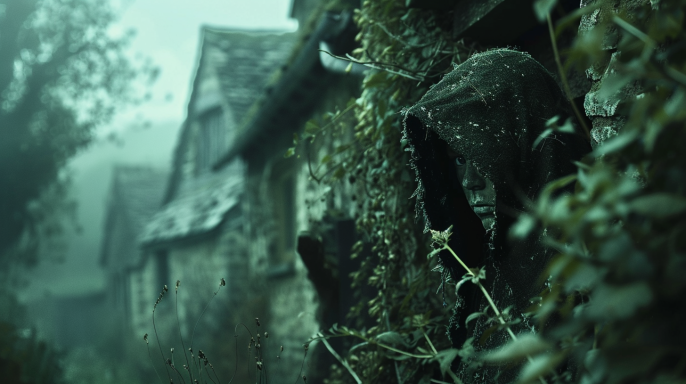Introduction
In the 12th century, two children with green skin reportedly appeared in the village of Woolpit, England. They spoke an unknown language and claimed to come from a land where the sun never shone. Their mysterious origin and eventual integration into society remain subjects of folklore and speculation. This article delves into the legend of the green children of Woolpit, exploring its historical context, various theories, and enduring legacy.
Historical Context
The legend of the green children is set in 12th century England, during the reign of King Stephen. Woolpit, a small village in Suffolk, was a typical medieval English settlement. The social and cultural backdrop of the time was characterized by superstition, folklore, and a strong belief in the supernatural.
Discovery of the Green Children
According to the legend, the green children were discovered by villagers near one of the wolf pits that gave Woolpit its name. The children, a boy and a girl, had green-tinted skin, wore strange clothing, and spoke an unknown language. They appeared disoriented and frightened, leading the villagers to take them in.
The Children’s Behavior
Initially, the children refused to eat any food offered to them. They eventually consumed raw broad beans, the only food they recognized. Over time, they began to eat other foods and their green skin gradually faded. The children’s behavior and inability to communicate added to the mystery surrounding them.
Integration into Society
Efforts were made to integrate the children into Woolpit society. They were baptized and given care by Sir Richard de Calne, a local landowner. The girl adapted more successfully than the boy, who fell ill and died shortly after their discovery. The girl’s health improved, and she eventually learned to speak English.
The Boy’s Fate
The boy’s early death left many questions unanswered. His passing was a significant turning point for the girl, who then had to navigate her new environment alone. Her survival and adaptation provided more insights into their mysterious background.
The Girl’s Story
The girl thrived in her new environment, learning English and integrating into local society. She worked as a servant in Sir Richard de Calne’s household and later married a man from King’s Lynn. Her eventual assimilation provided some resolution to the legend but did not fully explain her and her brother’s origins.
The Mystery of Their Origin
The girl recounted that they came from a land called “St. Martin’s Land,” where there was no sunlight and everything was green. This description sparked various theories about their origin, ranging from otherworldly explanations to more grounded interpretations.
Theories About the Green Children
The legend has inspired numerous theories over the centuries. Folklore and mythological interpretations suggest that the children came from a fairy realm or a parallel world. Scientific and rational explanations propose more plausible origins, such as their being lost orphans from a nearby community.
The St. Martin’s Land Theory
The “St. Martin’s Land” theory posits that the children came from an underground world or a distant land with unusual atmospheric conditions. Some speculate that they might have been refugees from a subterranean community affected by a natural disaster.
Hyperchlorhydria Hypothesis
One scientific hypothesis is that the children suffered from hyperchlorhydria, a condition that could cause greenish skin due to malnutrition and iron deficiency. This explanation aligns with their initial poor health and subsequent improvement with a varied diet.
Cultural Impact
The legend of the green children has significantly influenced local folklore and literature. It has been referenced in various works, from medieval chronicles to modern novels and films. The story’s enigmatic nature continues to captivate audiences and inspire new interpretations.
Historical Records and Accounts
Historical accounts of the green children come from two primary sources: Ralph of Coggeshall’s “Chronicum Anglicanum” and William of Newburgh’s “Historia rerum Anglicarum.” These records provide slightly different versions of the story, adding to the legend’s complexity.
Comparisons to Other Folklore
Similar legends of mysterious green-skinned beings appear in other cultures, suggesting a common motif in folklore. Comparative analysis reveals shared themes of otherworldly origins and integration into human society.
Modern Interpretations
Contemporary views on the legend range from treating it as a historical curiosity to seeing it as an allegory for immigration and assimilation. The story’s enduring appeal lies in its blend of mystery, cultural significance, and human interest.
Conclusion
The legend of the green children of Woolpit endures as a captivating mystery that blends history, folklore, and speculation. Despite various theories and interpretations, the true origin of the green children remains unresolved, adding to the story’s lasting legacy.
FAQs
Who were the green children of Woolpit?
The green children were a boy and a girl with green-tinted skin who appeared in Woolpit, England, in the 12th century. They spoke an unknown language and claimed to come from a sunless land.
What did the green children claim about their origin?
The girl claimed that they came from a place called “St. Martin’s Land,” where the sun never shone, and everything was green.
What theories exist about the green children’s green skin?
Theories include medical conditions like hyperchlorhydria, environmental factors, and mythological origins. The green skin could have been due to malnutrition and iron deficiency.
How did the green children integrate into Woolpit society?
The children were taken in by Sir Richard de Calne, baptized, and gradually adapted to local society. The girl survived and learned English, eventually marrying and integrating fully.
Why does the legend of the green children endure?
The legend endures due to its mysterious nature, cultural significance, and the various interpretations and theories it has inspired. It continues to captivate audiences and spark curiosity.

